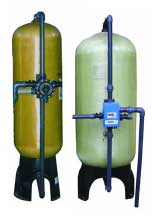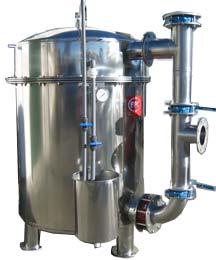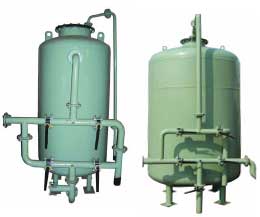Filtration is the process by which, physical impurities and suspended particles of water are filtered. Different methods are used for filtration. These are micron filters, media filters, pressure sand filters, activated carbon filters, dual media filters.
For any type of main water treatment & Purification, filtration is always necessary as a pre treatment.
Micron Water Filter
Cartridge filtration units generally operate most effectively and economically on applications having contamination levels of less than 50 �€“ 80 ppm. For heavier contamination applications, cartridges are normally used as final polishing filters. In the following the basic systems of cartridge filters are listed
Wound cartridge filters:
- the most common type of depth filters
- materials: natural or synthetic yards, which are wounded around a central tube or former
- numerous applications in the industry
Bonded cartridge filters:
- one-piece cordless construction, consisting of resin bonded fibers of solid particles
- their filtration range is between 5 to 125 micron, good chemical compatibility/flow rate
- frequent application: viscous fluids, process duties
Pleated cartridge filters:
- today's most common cartridge filter system
- materials: cellulose basis, resin impregnation; polyester, micro fiber glass, polypropylene
- advantages: increased surface area (up to 60 %) compared to traditional cartridge filters
Metal fiber cartridge filters:
- material: stainless steel fibers, connected to a mat
- used in the polymer industry
Hollow fiber membrane cartridge filters:
- for applications under 0.5 micron, for example used for the removal of aerosols.
Further applications can be, for example microbiology
(filtration range down to 0.01 micron), where sterility is very important
- materials: hydrophilic polyamide/polypropylene
Applications:
• Pre RO water
• Chemicals
• Beverages
• Solvents
• Compressed air
• Cosmetics
• Alcohol
Sand Water Filter
Sand filtration is frequently used and very robust method to remove suspended solids from water. The filtration medium consists of a multiple layer of sand with a variety in size and specific gravity. Sand filters can be supplied in different sizes and materials both hand operated or fully automatically.
Raw water pump is used for generating necessary operating pressure in the pressure sand filter. Raw water is passed through CHEMTRONICS Multigrade Sand Filter at a pressure of 3.5 kg / cm2 to reduce the suspended solids present in the raw water.
The filter will effectively remove up to 30 °C ; 50 micron of the suspended solids to less then 5 ppm. The filter will have to be washed with raw water for 20 to 30 minutes daily. To filter the partials below 30°C 50 micron cartridge filter is used.
Applications for sand filtration :
• Preparation of cooling water
• Treatment of waste water
• Production of drinking water
• Filtration in swimming pools
• Pre filtration for membrane systems
• Filtration of gray or surface water
• Swimming pool water

Pressure Sand Water Filter FR Series
Fiber Glass Reinforced Plastic (FGRP) composite vessels are 1/3 the weight of carbon steel, strengths are directly comparable to steel, no maintenance & high aesthetic appearance.
• High performance Composite material
• Thermoplastic liner of polyester �€“ wall thickness 3.8 mm
to 7.6 mm as per vessel diameter
• 100 % corrosion resistant
• Excellent bonding between inlet & PE liner
• Better curing at high temperature
• 200 mm to 1,000 mm diameter
• All are top opening & dia 450 mm onwards top & bottom opening
• 450 mm onward flange fitting
• Operating Pressure �€“ 10.5 kgf/cm2
• Operating temperature �€“ 490 C
• 250,000 times cycle test from 10 psi to 150 psi
• Vessels are NSF & PED certified

Pressure Sand Water Filter SS Series
Stainless steel pressure sand filters are widely used in following applications :
• Pharmaceutical product water
• Dairy & food products.
• Beverages
• Package drinking water
• Cosmetics

MS Series
Mild Steel (MS) pressure sand filters are commonly used across the world for
following applications :
• Filter high quantity of water.
• Thermoelectric power plants.
• Irrigation & farming
• Aqua culture.